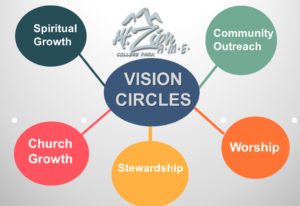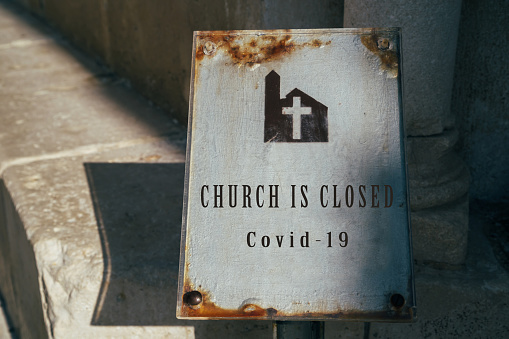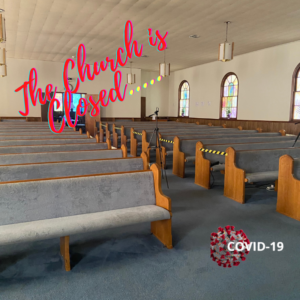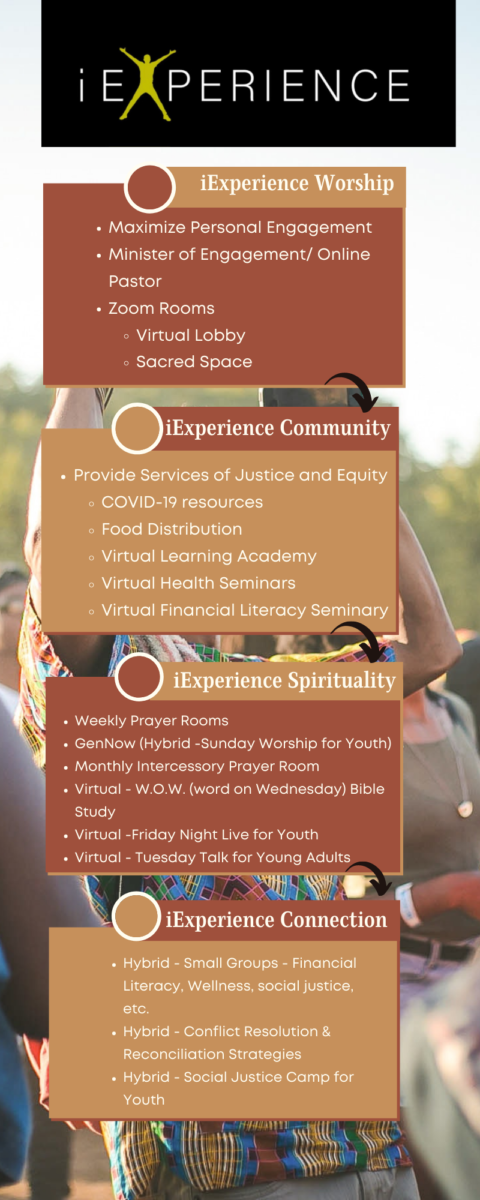PANDEMIC AND PANDEMONIUM!
It was not just our imagination in March of 2020, when the world shifted as we entered a period of change that was unprecedented in our lifetimes! What many of us thought was impossible or would only happen in the distant future, happened in the course of just a few days without warning. So many faith communities had to pivot quickly as we sought to continue to deliver worship in response to a virus that catapulted us into unknown. In this ‘new normal’ we are faced with the challenge of creating community in absentia. For the black church, this posed a particularly difficult question. How shall a congregation, particularly in the Black church tradition which is so deeply invested in a physical worship gathering as a communal experience, engage in a virtual space as a site for community building and spiritual formation? How might worship and small group gatherings change in the virtual space that will define and develop community in a new context? Is it possible for the black church to have flexibility and offer options to traditional worship and traditional community building that still meet the needs of our congregation while engaging the beloved community?
Yes it is possible! In fact, it is critical to the survival of the Black church to capitalize on this new normal to become relevant and relational. This project presented the argument that the Black church can indeed flourish by reimagining digital community spaces which enable engagement and connection. Community exists when individual can engage in social interaction that builds a personal connection with their faith and each other. Through the engagement in these new digital spaces personal connections can be created in a convenient and accessible environment; they can also expand the reach of the church into new areas and opportunities for engagement and results in the ultimate increased inclusion and increased impact of the ministry of the kingdom.
Pre-Pandemic Context
I serve as the Pastor of a traditional mainline denominational predominantly African American congregation in the metropolitan Atlanta area. As an Itinerant Elder in the African Methodist Episcopal Church, we are assigned annually to our charge for a one-year term. My assignment to Mt Zion AME Church located in College Park, Georgia was no different, within nine months of receiving my appointment, the church closed due to the pandemic.
This congregation had struggled for the past five years with a loss of membership and various financial challenges that left them somewhat hesitate to embrace quickly new and innovative ideas. They had been in a maintenance mode for the past five (5) years and needed to see the possibilities of the future and their ability to make those possibilities a reality. The idea of incorporating social media into their worship was being contemplated as a means to appeal to a mostly younger generation and a possible solution to the loss of millennial age worshippers. But like many small to midsized Black churches, utilizing social media and online streaming was limited to engaging Facebook Live as an afterthought or totally discarded due to limited resources. It was certainly not a central focus of their ministry planning and little thought was given to the possibility that it was a viable means of ministry engagement.

New Normal After Coronavirus. New normal road sign. Horizontal composition with copy space. Global Health and COVID-19 pandemic concept.
Pandemic Problem
Fast forward to March 2020, a radical shift occurred within the body of Christ, a shift that many had prayed for, a shift that was desired by many but definitely one that was not anticipated by many in such a profound and definitive fashion. There was no decision to be made as state mandated shelter in place orders removed options from Pastors and church leaders. Left without options, left with only the question of how and how long, we moved forward cautiously and confused, but we moved forward. There was no time to look back, we could only move forward to find a new way of worship, a new place of centering our connection with God and the reality that what we had many times preached and proclaimed was right before us; that God does not reside in the building but within each of us. This shift was also a reminder that we are called into the world not into the building.
Many of the scriptures we read and preached became a living testament to our faith traditions; we left the church building, uncertain and if the truth would ease from many lips we were fearful of the uncertainty and the unknown. We sought biblical texts to undergird us as we moved forward and we had to remind ourselves to “not be afraid, stand firm and see the deliverance of the Lord…Go Forward” [1] So the church moved forward or was pushed by a minute but powerful and potent virus that left the church with no opportunity to rethink what was coming next. Over the last several months many articles have been writing about these new phenomena of virtual worship and what it means for the ‘New Normal’ that we are and will continue to experience as we move with hopefulness toward a post-pandemic world. But what are we the church and specifically Pastors and church leader to say to these things; are we just in a holding pattern waiting to land back in the physical building or are we strategically planning for the new normal of church not as usual?
Has the realization set in that things will not ever return to the pre-pandemic version of normal ministry experiences and propel us to think beyond the physical constraints of the church to embrace unique opportunities that are viewed as God ordained instead of causalities of the COVID crises? “The Black Church’s essence of its spirituality has always been about finding healthy patterns of community. God’s image is community rather than individualistic.”[2] There is blank space on the wall for us to write the vision and make it plain for a new and compelling ministry practice and experience that has unlimited potential to expand the reach of our witness and worship to those who have for whatever reason come to see the institutional church as limiting and inhibiting to their spirituality. Ministry is not limited to a building or to a particular day of the week or as Thurman states “ too many people mistake going to church for following Jesus”. This shift further illustrates what Thurman references “Jesus does not belong to the church, but the church belongs to Jesus,” this enables us to understand the basic underpinning of evangelism, the church is to go into the world and not wait for the world to come to the church.[3] For too long that is what has been taking place. The pandemic driven culture has created a unique opportunity for us to shift, recalibrate and reimagine our meaning of spirituality as seen through our worship and our witness!
The opportunities are unlimited for the church to reimagine the creation of a kingdom culture in this new virtual environment. There is no longer the constraints of membership and limited geographical reach of the church. The church must awaken from its slumber and seize the opportunity that has been handed to it in the midst o f the unexpected and unanticipated upheaval of the pandemic. The church has been as Tacey states “ stuck between the comfortability of what was and the potential of what can be; we have out grown our current praxis as likened unto a pair of our favorite clothing item that no longer fits but we struggle to let them go and begin to wear the new clothing item.” [4] While we speak and seemingly seek change, many times when it actually occurs or as in this particular case is pressed upon us without warning, we respond with hesitancy and trepidation. If the church is to continue to be responsive and reach beyond its previous physical limitations to serve the present age then now is the time!
f the unexpected and unanticipated upheaval of the pandemic. The church has been as Tacey states “ stuck between the comfortability of what was and the potential of what can be; we have out grown our current praxis as likened unto a pair of our favorite clothing item that no longer fits but we struggle to let them go and begin to wear the new clothing item.” [4] While we speak and seemingly seek change, many times when it actually occurs or as in this particular case is pressed upon us without warning, we respond with hesitancy and trepidation. If the church is to continue to be responsive and reach beyond its previous physical limitations to serve the present age then now is the time!
Moving Forward
Was it a prophetic moment? I am not sure but three months prior to the March 2020 closure of Mt. Zion, church leaders had gathered for a visioning session to begin to determine the future direction of the church. Members were randomly placed into five circles and then rotated through each circle. During the rotation each group was given a set time limit to review the circle and reflect on what that circle represented to the ministry of Mt. Zion AME Church and how that circle could be brought to life within the ministry context of the church. That session would provide to be critical to our approach to ministry as the traditional patterns of ministry ceased to exist because of the pandemic. The results of that session enabled the church to not only meet the challenge of creating a digital community but also allowed us to continue to adjust to the shifts in dynamics of virtual engagement both in our worship experience and community engagement. The reality is that even as the world returns to some sense of normalcy with the return to workplaces and school; the same return has not been evident in the Black church for in-person engagement. We must not abandon the lessons learned in the last two years but continue to incorporate and build upon the innovative strategies of the virtual experience to meet both the needs of returning congregations and those in the community who will not return or even continue to see the relevancy of organized religion. So, then how to begin this work within this new and mostly uncharted territory?
We were each given talents and abilities by God that is to be used to build the Kingdom of God. The iExperience Project developed after a critical analysis of the vision circles and assessing the resources available to us during the limitations of operating within the restrictions of the global pandemic protocols.
The iExperience movement is created to holistically equip the members of Mt. Zion A.M.E. Church of College Park, GA to not only deepen their personal relationships with Jesus Christ, but to also serve as true disciples of Christ outside of the four walls of the building. This includes pouring into the surrounding community with inclusiveness (the practice or policy of providing equal access to opportunities and resources for people who might otherwise be excluded or marginalized, such as those having physical or mental disabilities or belonging to other minority groups) with the love that Christ continues to grace us with. This inclusiveness extends to those that are unchurched and those that fail to see organized religion as relevant to current issues and socio-economic concerns.
Resources
- Bishop, Justin. Sensing God Online. Macon, Ga: Smith & Helwys Publishing, Inc.,2021
- Brown, Olu. 4D Impact: Smash Barriers like a Smart Church. Nashville, TN: Abingdon Press, 2019
- Jones, Nona J. From Social Media to Social Ministry: A Guide to Digital Discipleship. Grand Rapids, MI: Zondervan Reflective, 2020.
Notes
[1] NRSV, National Council of Churches of Christ in the U.S.A. 2003
[2] Michael Battle, The Black Church in America: African American Christian Spirituality (Malden, MA: Blackwell Pub., 2006), XV.
[3] Ellison, Anchored in the Current: Discovering Howard Thurman as Educator, Activist, Guide, and Prophet (Louisville, KY: Westminster John Knox Press, 2020), 33.
[4] Tacey, David. The Spirituality Revolution the Emergence of Contemporary Spirituality. New York, NY: Routledge, Taylor & Francis Group, 2011.


